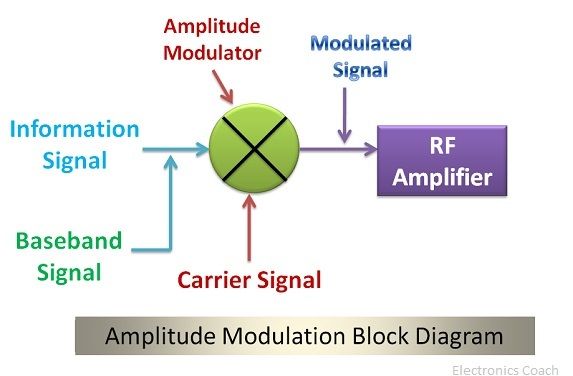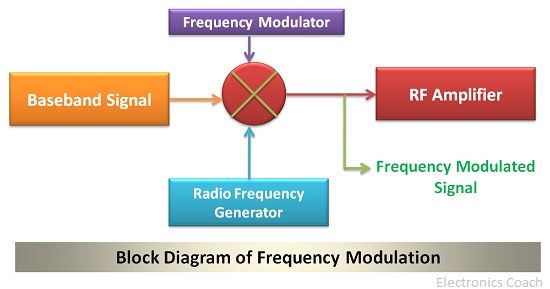Amplitude Modulation and frequency modulation, both are the type of transmission techniques for transmitting information from sender to receiver. But the similarities between the two ends here. Amplitude modulation involves the modulation of the carrier signal according to the amplitude of the baseband signal. However, the frequency and phase of the carrier signal will not be changed.
On the contrary, frequency modulation involves the modulation of the carrier signal according to the frequency of the baseband or information signal. Thus, the major difference between the amplitude modulation and frequency modulation is that the amplitude modulation is the process of modulating the amplitude of the carrier signal, while frequency modulation is the modulation of the frequency of the carrier signal.
Another significant term which creates the difference between these two modulation techniques is the bandwidth requirement. The bandwidth requirement in case of amplitude modulation is very less as compared to frequency modulation.
We will discuss some other crucial differences between amplitude modulation and frequency modulation like frequency range, quality of transmission etc. with the help of comparison chart. But before discussing the comparison chart, let’s put light on the crucial cornerstone of this article.
Content: Amplitude Modulation and Frequency Modulation
Comparison Chart
| Parameters | Amplitude Modulation | Frequency Modulation |
|---|---|---|
| Definition | The amplitude of the carrier wave is modulated according to the value of the amplitude of the information signal. | The frequency of the carrier wave is modulated according to the value of the frequency of the information signal. |
| Circuit designing | Simple | Complex |
| Cost of the circuit | It is less costly. | It is more costly than amplitude modulation technique. |
| Bandwidth requirement | The bandwidth requirement is low in the range of 10 kHz. | The bandwidth requirement is high in the range of 200 kHz. |
| Area of reception | The area of reception is large. | The area of reception is limited in comparison to that of amplitude modulation system. |
| Constant terms | The frequency and phase is constant. | The amplitude and phase is constant. |
| Power | The wastage of power is more in amplitude modulation because the significant part of the power is carried by the carrier signal which do not contain any information. | The power is utilized properly, because all transmitted power is carried by the information signal. |
| Noise Immunity | The amplitude modulation system is not immune from noise distortion as frequency deviation technique and amplitude delimiters cannot be utilized in amplitude modulation system. | The frequency modulation is more immune to noise distortion because we can use frequency deviation technique and amplitude delimiters. |
| Quality of reception | Low quality signal is obtained. | The received signal is of high quality. |
Definition of Amplitude Modulation
The amplitude modulation is the process of transmitting the information signal by superimposing it on the high-frequency wave called carrier wave. The information signal can be of any type based on the type of information it is carrying such as voice, data etc.

The frequency of the information signal which is also known as the baseband signal is extremely low. The frequency of the signal is directly related to the energy of the signal. Thus, if signal frequency is very low then the signal will get attenuate after travelling a certain distance. In order to avoid the attenuation of the signal, it is superimposed on the high-frequency carrier wave.
In case of amplitude modulation, the amplitude of the carrier wave modulates, i.e. it varies with the amplitude of the information signal. Thus, the modulation is called amplitude modulation. It is to be noted that the frequency and the phase of the carrier remain constant during amplitude modulation.
The main drawback of the using amplitude modulation technique is the lower efficiency and poor quality. The modulated signal obtained from amplitude modulator does not resemble the transmitted signal as its quality gets degraded. Besides, the noise immunity of amplitude modulators is also poor.
The advantage of using amplitude modulation technique is that it requires low bandwidth which makes it less costly.
Frequency Modulation
The frequency modulation is the technique of modulation in which the frequency of the carrier signal is varied in accordance with the frequency of the information or baseband signal keeping the amplitude of carrier signal constant.

The frequency modulator performs the modulation task, in this carrier signal from radio frequency generator and the information signal from the information source is introduced. The modulated signal is then passed to RF amplifier which ameliorates the necessary attenuations.
The main advantage of using the frequency modulation technique for transmission is that quality of the transmitted signal does not deteriorate. But the frequency modulation system is complex to design thus, the cost of such system are quite high.
The frequency modulation system is immune to noise distortion. Thus, the effect of noise on the frequency modulated signal is extremely low that it can be neglected.
Key Differences between Amplitude Modulation and Frequency Modulation
- The operation mechanism of amplitude modulation and frequency modulation creates the key difference between these transmission technologies. Amplitude modulation deals with the carrier which is modulated by the amplitude of the signal, while frequency modulation technique deals with the carrier which is modulated by the frequency of the modulated signal.
- The quality of the received signal varies in both the techniques. The amplitude limiters can be fitted with frequency modulation system. Thus, the distortions due to noise signal can be minimized in frequency modulation system. On the contrary, the amplitude modulators cannot be equipped with amplitude limiters.
- The frequency deviation technique also reduces the noise and can exponentially increase the quality of the signal, but the technique of frequency deviation is not possible in amplitude modulation. This makes the frequency modulation better in comparison to amplitude modulation.
- The bandwidth requirement also plays a pivotal role in differentiating amplitude modulation and frequency modulation. The frequency modulation system requires high bandwidth in the range of 200kHz. While the amplitude modulation system requires bandwidth in the range of 10kHz for the broadcasting information signal.
- The circuit architecture of frequency modulation system is very complex in comparison to amplitude modulation system.
- The amplitude modulation and frequency modulation also differs in the cost of the system. The complex design of the frequency modulation system makes it costly in comparison to amplitude modulation system.
Conclusion
The amplitude modulation and frequency modulation, both are the crucial technologies of the communication system. Our requirements and specification of applications decide which of the above-mentioned modulation technique should be used. If we are dealing with such an application in which we cannot compromise with the quality of reception, then we should opt for frequency modulation system.
However, if we are dealing with such an application that we needn’t maintain the quality of the reception and looking for the cheap and simple technique then we should go for amplitude modulation technique.
Leave a Reply